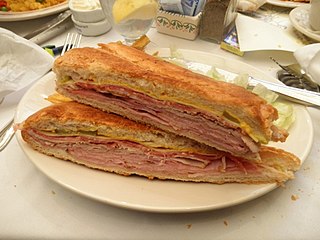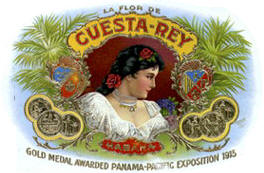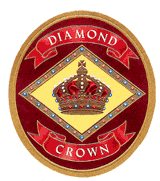
A cigar is a rolled bundle of dried and fermented tobacco leaves made to be smoked. Cigars are produced in a variety of sizes and shapes. Since the 20th century, almost all cigars are made of three distinct components: the filler, the binder leaf which holds the filler together, and a wrapper leaf, which is often the highest quality leaf used. Often there will be a cigar band printed with the cigar manufacturer's logo. Modern cigars can come with two or more bands, especially Cuban cigars, showing Limited Edition bands displaying the year of production.

A Cuban sandwich is a variation of a ham and cheese sandwich that likely originated in cafes catering to Cuban workers in Tampa or Key West, two early Cuban immigrant communities in Florida centered on the cigar industry. Later on, Cuban exiles and expatriates brought it to Miami, where it is also very popular. The sandwich is made with ham, (mojo) roasted pork, Swiss cheese, pickles, mustard, and sometimes salami on Cuban bread. Salami is included in Tampa, but is not usually included in South Florida.

Alfonso Ramón López was a Spanish-American professional baseball catcher and manager. He played in Major League Baseball (MLB) for the Brooklyn Robins / Dodgers, Boston Bees, Pittsburgh Pirates, and Cleveland Indians between 1928 and 1947, and was the manager for the Cleveland Indians and the Chicago White Sox from 1951 to 1965 and during portions of the 1968 and 1969 seasons. Due to his Spanish ancestry and "gentlemanly" nature, he was nicknamed "El Señor".

Ybor City is a historic neighborhood just northeast of downtown Tampa, Florida, United States. It was founded in the 1880s by Vicente Martinez-Ybor and other cigar manufacturers and populated by thousands of immigrants, mainly from Cuba, Spain, and Italy. For the next 50 years, workers in Ybor City's cigar factories rolled hundreds of millions of cigars annually.

Cuban cigars are cigars manufactured in Cuba from tobacco grown within that island nation. Historically regarded as among the world's "finest", they are synonymous with the island's culture and contribute over one quarter of the value of all exports from the country.

West Tampa is one of the oldest neighborhoods within the city limits of Tampa, Florida, United States. It was an independently incorporated city from 1895 until 1925, when it was annexed by Tampa.

Arturo Fuente is a cigar brand founded by Arturo Fuente, Sr. in 1912 in West Tampa, Florida. Following a catastrophic fire in 1924, the brand had a production freeze for 22 years, reemerging in 1946 on a limited, local basis. Ownership was transferred to Arturo's younger son, Carlos Fuente, Sr. in 1958. Following the 1960 United States embargo of Cuba, the Fuente brand began a period of slow and steady growth, emerging as one of the most critically acclaimed makers of hand-rolled premium cigars outside of Cuba. As of 2010, the company was producing 30 million cigars per annum from its factory in the Dominican Republic.

The Ybor City Historic District is a U.S. National Historic Landmark District located in Ybor City, Tampa, Florida. The district is bounded by 6th Avenue, 13th Street, 10th Avenue and 22nd Street, East Broadway between 13th and 22nd Streets. Ybor City contains a total of 956 historic buildings, including an unparalleled collection of architecture with Spanish-Cuban influence, as well as historic cigar factory buildings and associated infrastructure. The area was developed by businessman Vicente Martinez Ybor beginning in 1886, and was for a time the world's leading supplier of cigars.

The Ybor Factory Building is a historic site in Tampa, Florida, United States located at 1911 North 13th Street. The main factory and its surrounding support buildings cover an entire city block between 8th Avenue and 9th Avenues and 13th and 14th Streets in the Ybor City Historic District section of the Ybor City neighborhood. C. E. Parcell is credited as the building's architect.

Don José "Pepin" Garcia is the CEO of El Rey de los Habanos, Inc, a cigar company in Miami, also known as My Father Cigars. He is a noted cigar maker living in Miami, Florida. Born in Cuba, he is a master cigar roller and blender, and the creator and maker of numerous popular cigar brands.

Cuesta-Rey is a brand of handmade cigar, founded in 1884 by Angel LaMadrid Cuesta and Peregrino Rey. Cuesta, a Spaniard, had apprenticed in cigar making in Cuba before he met Rey. They formed the company in the Ybor City district of Tampa, Florida to make 'clear Havana' cigars. As well as making their own brands they made cigars for other companies such as Nat Sherman.

Diamond Crown is a brand of cigar handmade by Tabacalera A. Fuente in the Dominican Republic for the J.C. Newman Cigar Company.

Diamond Crown Maximus is a super premium cigar brand handmade by Tabacalera A. Fuente in the Dominican Republic for the J.C. Newman Cigar Company.

Vicente Martinez Ybor was a Spanish entrepreneur who first became a noted industrialist and cigar manufacturer in Cuba, then Key West, and finally Tampa, Florida.

Ybor City is a historic neighborhood that includes the Ybor City Historic District in Tampa, Florida. It is located just northeast of downtown Tampa and north of Port Tampa Bay. The neighborhood has distinct architectural, culinary, cultural, and historical legacy that reflects its multi-ethnic composition. It was unique in the American South as a prosperous manufacturing community built and populated almost entirely by immigrants.

Thompson Cigar Company is a cigar and cigar accessories retailer located in Tampa, Florida. Thompson Cigar is the oldest mail order cigar company in the United States. Originally located in Key West, Florida, Thompson Cigar first opened in 1915. In 1920, after hurricanes decimated most of the cigar factories in Key West, original owner M.A. Thompson moved his factory to Ybor City, located in Tampa, Florida, known as "Cigar Capital of the World." Thompson acquired Postal Permit #1 in the city of Tampa, which it still holds today. In 1934, M.A. Thompson moved his factory to Bartow, Florida where it would remain until 1960.

Perdomo is a brand of cigars primarily grown and produced in Nicaragua and sold worldwide by Tabacalera Perdomo. Manufactured by Perdomo Cigars, the company is a family owned and operated business headquartered in Miami Lakes, Florida and headed by CEO Nick Perdomo, Jr.

Frank Anthony Llaneza was a tobacco blender and former executive of Villazon & Co. who is regarded as a pioneer in the resurgence of the premium cigar industry at the end of the 20th Century. Llaneza is best known for the creation and manufacture of a number of popular cigar brands in the years after the 1962 Cuban Embargo, including Hoyo de Monterrey, Punch, Bolivar, and Siglo.

The Ybor cigar makers' strike of 1931 took place in Ybor City, Tampa, Florida, starting on November 26 and ended in December. Some strikers were jailed, "Lectors" were banned and there was a lockout. Following legal intervention, some workers returned to work at previous wage levels but others were not re-employed. Lectors had by tradition been elected by the workers and, as well as reading aloud newspaper articles, often from left-wing radical publications, they recited and acted more generally, including from classic works – effectively they provided a form of education for illiterate workers. The most significant effect of the strike in the longer term was that the lector culture was brought to an end.

Cuban immigration to the United States, for the most part, occurred in two periods: the first series of immigration of wealthy Cuban Americans to the United States resulted from Cubans establishing cigar factories in Tampa and from attempts to overthrow Spanish colonial rule by the movement led by José Martí, the second to escape from Communist rule under Fidel Castro following the Cuban Revolution. Massive Cuban migration to Miami during the second series led to major demographic and cultural changes in Miami. There was also economic emigration, particularly during the Great Depression in the 1930s. As of 2019, there were 1,359,990 Cubans in the United States.





















